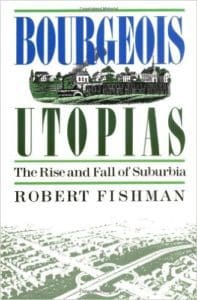 FROM THE VAULT | Bourgeois Utopias: The Rise and Fall of Suburbia by Robert Fishman
FROM THE VAULT | Bourgeois Utopias: The Rise and Fall of Suburbia by Robert Fishman
Review by Dr. Mark David Major, AICP, CNU-A, The Outlaw Urbanist contributor
I’ve been an admirer of historian Robert Fishman ever since reading Urban Utopias in the Twentieth Century (MIT Press, 1982) in the early 90s but especially after hearing him speak at CNU20 in West Palm Beach, FL in 2012. Given this, I was a naturally excited to read this book when I came across it many years after its publication. However, I have to begrudgingly admit I was mostly underwhelmed by Bourgeois Utopias: The Rise and Fall of Suburbia (Basic Books, 1987). Partially, this is a matter of timing. When Fishman wrote and published this book in the late 1980s, it seemed like the cumulative apex of suburban expansion and urban decline in the United States. In hindsight, Fishman’s history of suburbia come across as a dated, unconditional surrender to what must have seemed to many people at the time as the inevitable (despite the ‘fall’ mentioned in book’s title). Of course, we now realize there was still a significant part of the story waiting to play out over the subsequent three decades (see New Urbanism/Smart Growth, collapse of the mortgage bond market, and 2008 Financial Crisis).
However, it is not all a matter of timing. Fishman is so determined to fit his subject into the thematic structure began in Urban Utopias in the Twentieth Century that he tends to cast aside any evidence contrary to his central thesis, especially when it comes to the American experience of suburbia. For example, you will not find the phrases ‘exclusionary zoning’ or ‘restrictive covenants’ anywhere in Bourgeois Utopias, which seems like an odd oversight for a purported history of suburbia. Fishman also oddly ignores ample evidence in the historical record (as well as John Reps’ seminal histories The Making of Urban America: A History of City Planning in the United States and Cities of the American West: A History of Frontier Urban Planning) that there were, in fact, only a few examples of the modern American suburb type (Llewellyn Park, New Jersey and Frederick Law Olmsted’s Riverside, Illinois being the most obvious 19th century forerunners) before World War II because the regular grid dominated in American land speculation activities until the onset of the Great Depression in 1929.
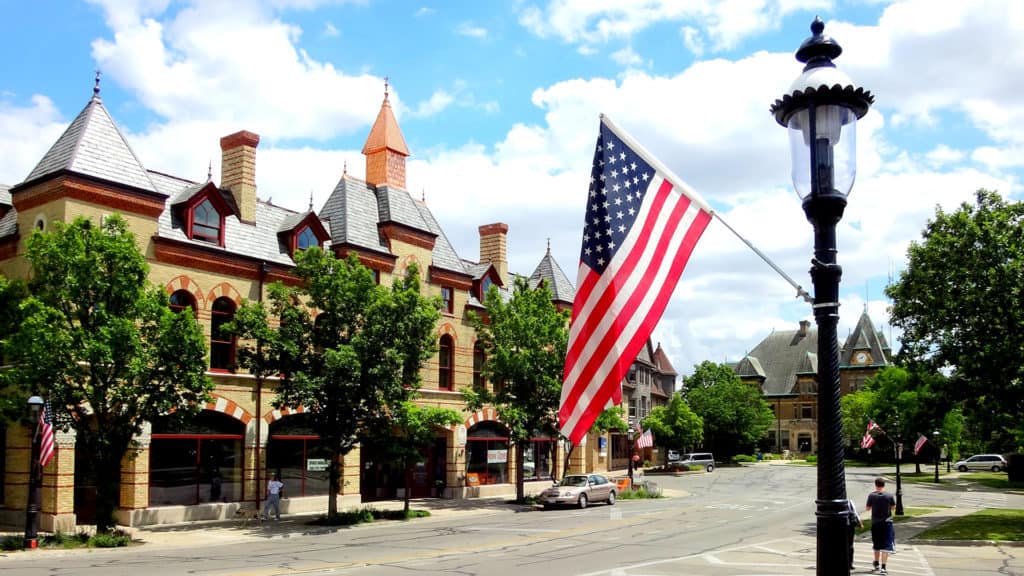
This creates a problem because Fishman has to, more or less, cast aside the narrow, formal definition of suburbia he adopts at the start of the book when discussing early suburbs in London and Manchester, England for a much looser definition (basically, any single family home with front yard setbacks) when approaching the American experience, especially in Los Angeles. In fact, Fishman’s entire chapter on Los Angeles reads as a regurgitation of Reyner Banham’s arguments in Los Angeles: The Architecture of Four Ecologies (1971) so both have the same flaws in underestimating the power of the urban grid. It is also another case in bad timing since Mike Davis’ City of Quartz: Excavating the Future in Los Angeles was published only a few years later in 1990. Davis’ book has its own flaws but it is an invaluable resource for understanding the historical development of urban form in Los Angeles including the role of water pilfering in that city as well as the insidious role of the automobile industry in the Red Car’s demise.
By far, the best and most compelling part of Bourgeois Utopias is Fishman’s research on early suburbs in England during 18th and 19th century and Olmsted’s mid-19th century plan for Riverside, Illinois (basically, pages 1-148). Indeed, any reader should be able to sense the author’s greater interest in these pre-20th century examples compared to the amalgamated cancer of 20th century suburbanization in the United States, when it seems as if Fishman is trying to ‘run out the clock’ on the book. In fact, if Fishman wasn’t so determined to ambitiously fit this topic into the ‘utopia’ theme, he might have been better served to limit his historical research to these pre-20th century examples. Fishman astutely identifies the changing nature of family related to longer life expectancy during the 18th and 19th century in England as the social origins for suburbia. Fishman briefly mentions life expectancy (which seems far more important than the words given in this book) before devoting most of his time to the evolution of familial relations in the workplace and/or home. Fishman also makes an important, useful distinction between the productive and consumptive suburb that has broader implications than spelled out in the book. It is fascinating research, which alone makes the book worth the effort. In the end, though, there are some good parts (Anglo examples) and some head-scratching parts (American examples) in Bourgeois Utopias: The Rise and Fall of Suburbia so the book deserves, at best, only a 3-star rating.

 Bourgeois Utopias: The Rise and Fall of Suburbia
Bourgeois Utopias: The Rise and Fall of Suburbia
by Robert Fishman
Basic Books, 1987
Paperback, 272 pages, English
ISBN-10: 0465007473
ISBN-13: 978-0465007479
You can purchase Bourgeois Utopias: The Rise and Fall of Suburbia from Amazon here.
From the Vault is a series from the Outlaw Urbanist in which we review art, architectural and urban design texts, with an emphasis on the obscure and forgotten, found in second-hand bookstores.

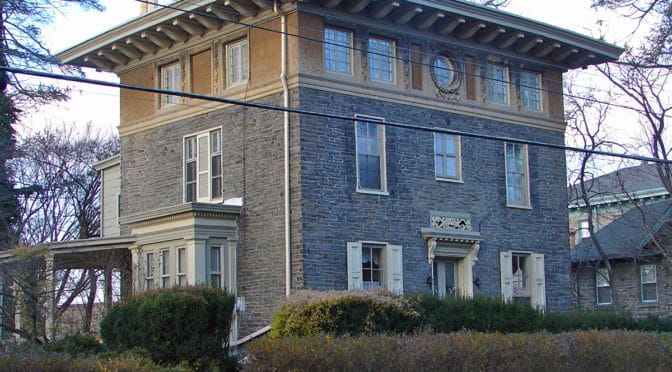

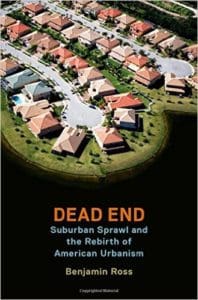
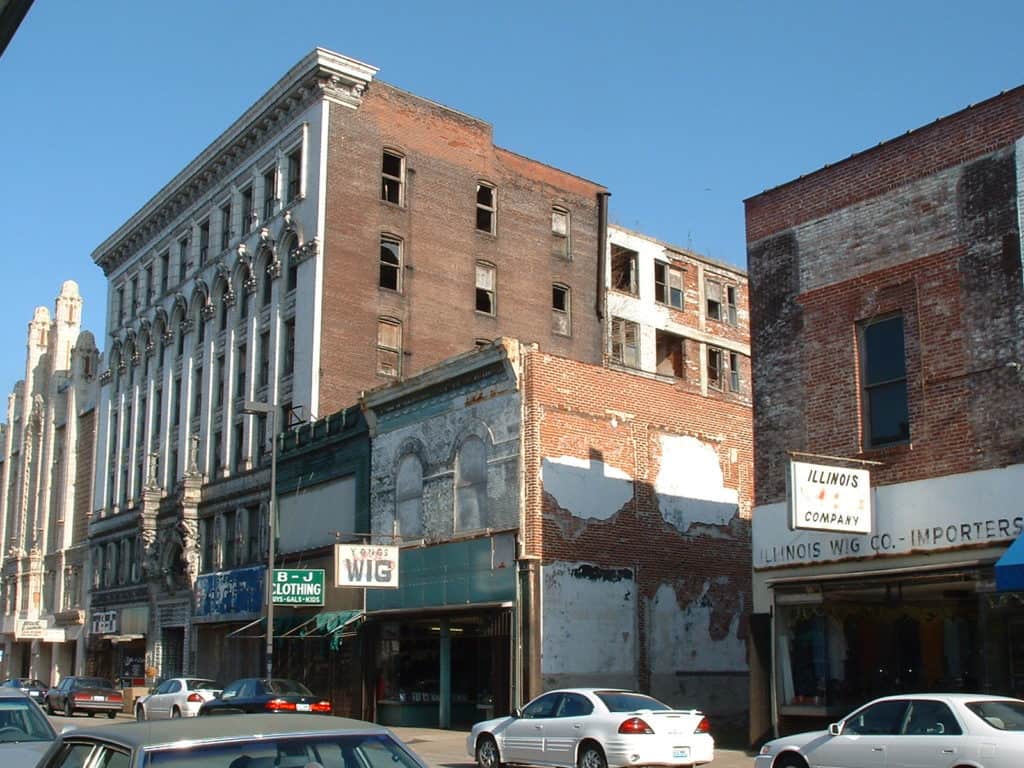 During the second half of Dead End: Suburban Sprawl and the Rebirth of American Urbanism, Ross also promotes the classic Smart Growth fallacy that public rail transit is the ‘magic bullet’ for reviving our cities. Indeed, public rail transit is important but too often Ross – like many others – comes across as unconsciously applying Harris and Ullman’s multi-nuclei model of city growth, which conveniently holds almost any function (in this case, rail stations/lines) can be randomly inserted almost anywhere in the fabric of a city without repercussions as long as land uses are ‘compatible.’ Of course, this is the
During the second half of Dead End: Suburban Sprawl and the Rebirth of American Urbanism, Ross also promotes the classic Smart Growth fallacy that public rail transit is the ‘magic bullet’ for reviving our cities. Indeed, public rail transit is important but too often Ross – like many others – comes across as unconsciously applying Harris and Ullman’s multi-nuclei model of city growth, which conveniently holds almost any function (in this case, rail stations/lines) can be randomly inserted almost anywhere in the fabric of a city without repercussions as long as land uses are ‘compatible.’ Of course, this is the 
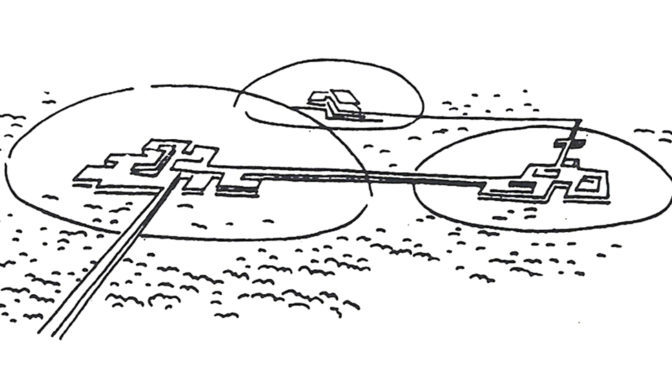
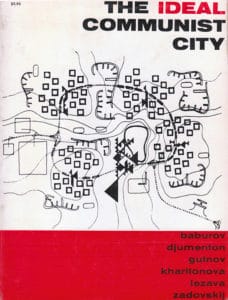
 Of course, the key difference is the authors’ explicitly state the failure of these ideas to “reach their full potential” in Western societies is due to the corrupting influence of capitalism as a political and economic system. This is a conceit that has been badly exposed with time. If anything, capitalism more ruthlessly exploited the economic potentials of Modern ideas by taking them to their logical and, ultimately, extreme conclusion; probably more so than even most devoted CIAM architect ever imagined. The real danger about The Ideal Communist City is that younger readers (Millennials and generations thereafter) without any first-hand experience of the Cold War might make the mistake of thinking they are reading something original and entirely different because it’s wearing Soviet-era clothing. However, it is the same, tired planning paradigm we have been hearing about and (unfortunately) living with over the last 80+ years. To be fair, another key difference in this book is the desire of Soviet-era planners to adopt a model that segregates land uses from one another while still actively promoting manufacturing, mass production, and industrialization. Younger readers might also think this represents a somewhat unique perspective from the point of view of architecture and planning. However, it is really only evidence of Soviet preoccupation – even obsession – with Western societies’ manufacturing prowess at the time. In this sense, Soviet failure to compete with the success of Western capitalistic societies contradicted the ‘means of production’ arguments underpinning Karl Marx and Frederick Engel’s The Communist Manifesto and Marx’s Das Capital; that is, direct evidence that communism was a flawed political and economic system based on totalitarianism masquerading as a false ideology
Of course, the key difference is the authors’ explicitly state the failure of these ideas to “reach their full potential” in Western societies is due to the corrupting influence of capitalism as a political and economic system. This is a conceit that has been badly exposed with time. If anything, capitalism more ruthlessly exploited the economic potentials of Modern ideas by taking them to their logical and, ultimately, extreme conclusion; probably more so than even most devoted CIAM architect ever imagined. The real danger about The Ideal Communist City is that younger readers (Millennials and generations thereafter) without any first-hand experience of the Cold War might make the mistake of thinking they are reading something original and entirely different because it’s wearing Soviet-era clothing. However, it is the same, tired planning paradigm we have been hearing about and (unfortunately) living with over the last 80+ years. To be fair, another key difference in this book is the desire of Soviet-era planners to adopt a model that segregates land uses from one another while still actively promoting manufacturing, mass production, and industrialization. Younger readers might also think this represents a somewhat unique perspective from the point of view of architecture and planning. However, it is really only evidence of Soviet preoccupation – even obsession – with Western societies’ manufacturing prowess at the time. In this sense, Soviet failure to compete with the success of Western capitalistic societies contradicted the ‘means of production’ arguments underpinning Karl Marx and Frederick Engel’s The Communist Manifesto and Marx’s Das Capital; that is, direct evidence that communism was a flawed political and economic system based on totalitarianism masquerading as a false ideology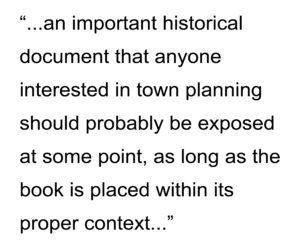 Having said all that, The Ideal Communist City is an important historical document that anyone interested in town planning should probably be exposed at some point, as long as the book is placed within its proper context for readers, especially post-Cold War ones. There are, in fact, relatively few flights of fancy in this book; the most amusing one being the common idea in science fiction that cities will eventually be covered by climate-controlled plastic domes (see Featured Image of this post at the top). The authors’ statistical projections of urban populations are way off, hilariously so. Early in the book, the authors project that 75% of the world’s population will live in urban areas by the year 2000 when it fact we only passed the 50% threshold in the last decade (due to the corrupting influence of capitalism, no doubt). The model of the NUS stretches believability despite the authors’ best – though somewhat halfhearted – efforts to address accommodating population growth during the transition period between one NUS being occupied and the next one being constructed. This is because these Soviet-era planners ultimately have a static view of the city. In hindsight, one might fairly argue the communist NUS model has already been better implemented and realized in cities such as Milton Keynes in England, the Pilot Plan of Brasilia in Brazil, or perhaps even some areas of America Suburbia, despite the problematic nature of such places as extensively discussed elsewhere in the literature. In the end, the Ideal Communist City is perhaps best at asking some interesting questions about cities but the answers provided are all too familiar and depressing to seriously contemplate. As Christopher Alexander famously said, “a city is not a tree.” It seems the same is as true for communist cities as it ever was for capitalistic ones. In the end, human nature is always more pervasive than any political ideology.
Having said all that, The Ideal Communist City is an important historical document that anyone interested in town planning should probably be exposed at some point, as long as the book is placed within its proper context for readers, especially post-Cold War ones. There are, in fact, relatively few flights of fancy in this book; the most amusing one being the common idea in science fiction that cities will eventually be covered by climate-controlled plastic domes (see Featured Image of this post at the top). The authors’ statistical projections of urban populations are way off, hilariously so. Early in the book, the authors project that 75% of the world’s population will live in urban areas by the year 2000 when it fact we only passed the 50% threshold in the last decade (due to the corrupting influence of capitalism, no doubt). The model of the NUS stretches believability despite the authors’ best – though somewhat halfhearted – efforts to address accommodating population growth during the transition period between one NUS being occupied and the next one being constructed. This is because these Soviet-era planners ultimately have a static view of the city. In hindsight, one might fairly argue the communist NUS model has already been better implemented and realized in cities such as Milton Keynes in England, the Pilot Plan of Brasilia in Brazil, or perhaps even some areas of America Suburbia, despite the problematic nature of such places as extensively discussed elsewhere in the literature. In the end, the Ideal Communist City is perhaps best at asking some interesting questions about cities but the answers provided are all too familiar and depressing to seriously contemplate. As Christopher Alexander famously said, “a city is not a tree.” It seems the same is as true for communist cities as it ever was for capitalistic ones. In the end, human nature is always more pervasive than any political ideology.
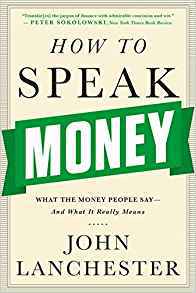
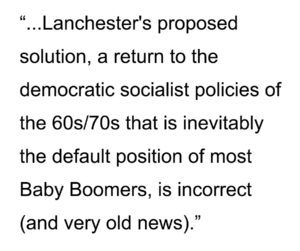 This means Lanchester’s proposed solution, a return to the democratic socialist policies of the 60s/70s that is inevitably the default position of most Baby Boomers, is incorrect (and very old news). As I recall, Reagan/Thatcher never supported the concept of near-monopolies as part of their broader economic strategy, which has, in fact, emerged in modern corporatism of the Western societies over the last 2-3 decades. This suggests that economic model we should be looking towards for a correction in the obvious abuses of the Neo-Liberal economic model (see bank fraud/credit crunch of the Great Recession) lies in the early 20th century ‘trust-busting’ model of Teddy Roosevelt. In this sense, the “Afterwood” serves its purpose by forcing anyone with a basic understanding of history and economics to draw to their own, more rational conclusions in order to reconcile the inherent contradictions of Lanchester’s argument. How to Speak Money: What the money people say… and what they really mean is worth the read but it should be read thoughtfully, not blindly. Grade: 3 1/2 stars
This means Lanchester’s proposed solution, a return to the democratic socialist policies of the 60s/70s that is inevitably the default position of most Baby Boomers, is incorrect (and very old news). As I recall, Reagan/Thatcher never supported the concept of near-monopolies as part of their broader economic strategy, which has, in fact, emerged in modern corporatism of the Western societies over the last 2-3 decades. This suggests that economic model we should be looking towards for a correction in the obvious abuses of the Neo-Liberal economic model (see bank fraud/credit crunch of the Great Recession) lies in the early 20th century ‘trust-busting’ model of Teddy Roosevelt. In this sense, the “Afterwood” serves its purpose by forcing anyone with a basic understanding of history and economics to draw to their own, more rational conclusions in order to reconcile the inherent contradictions of Lanchester’s argument. How to Speak Money: What the money people say… and what they really mean is worth the read but it should be read thoughtfully, not blindly. Grade: 3 1/2 stars


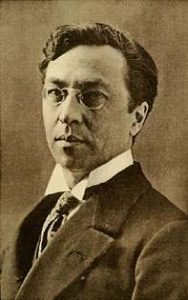 About Wassily Kandinsky
About Wassily Kandinsky